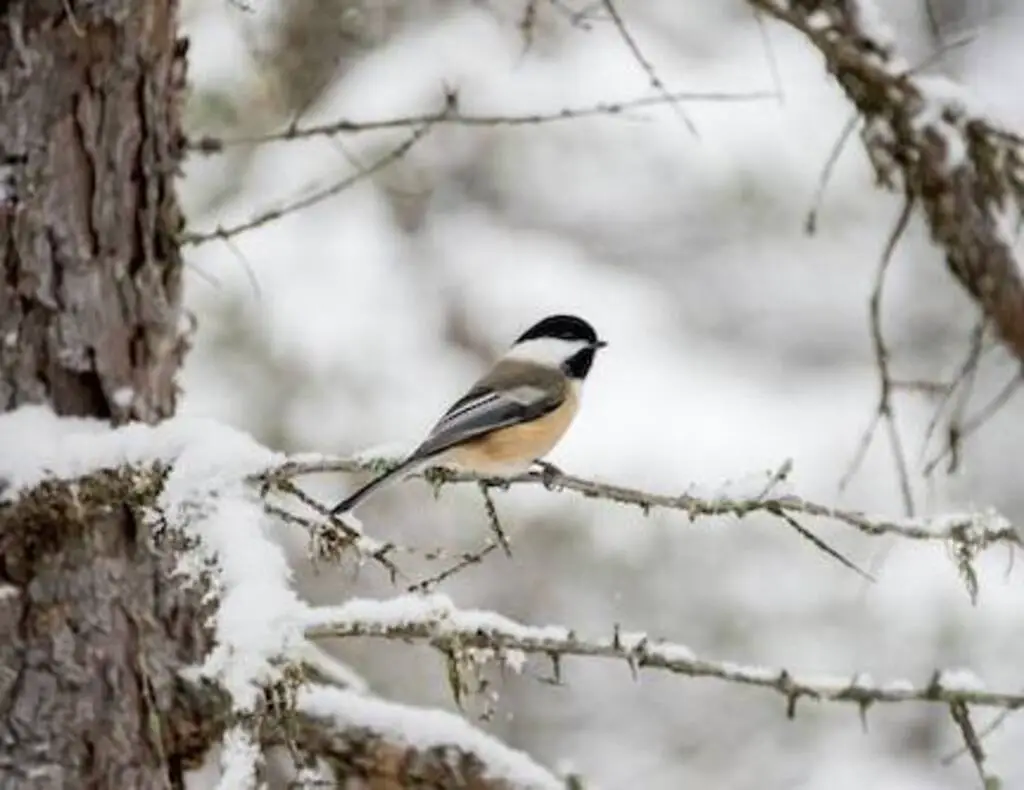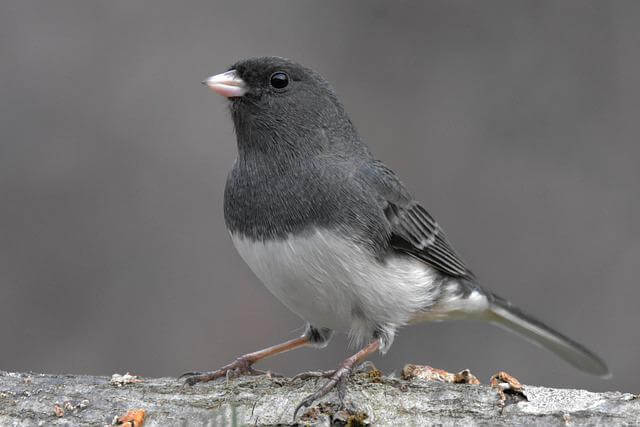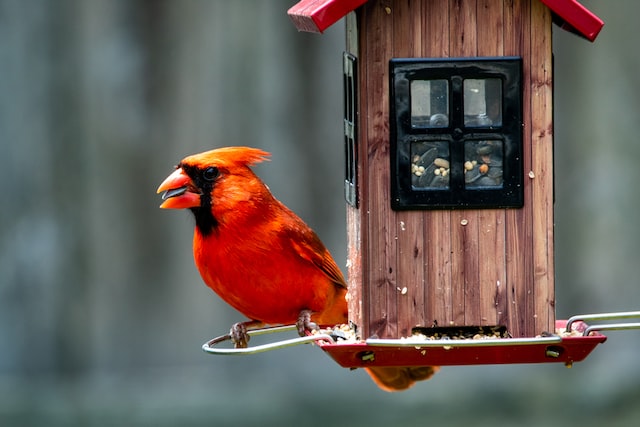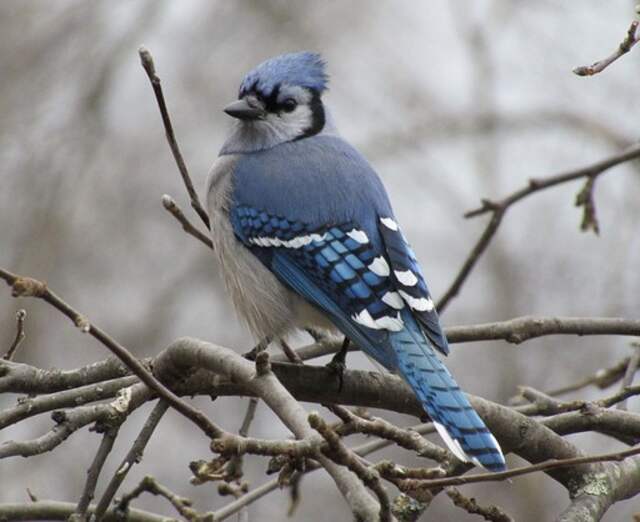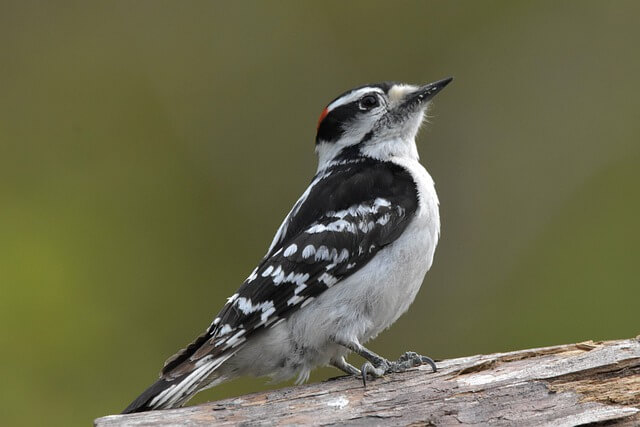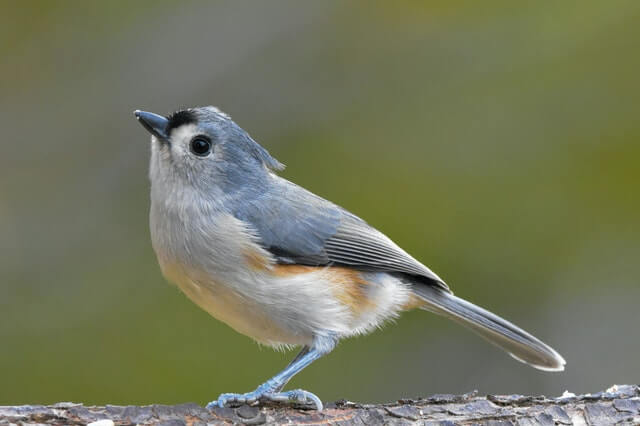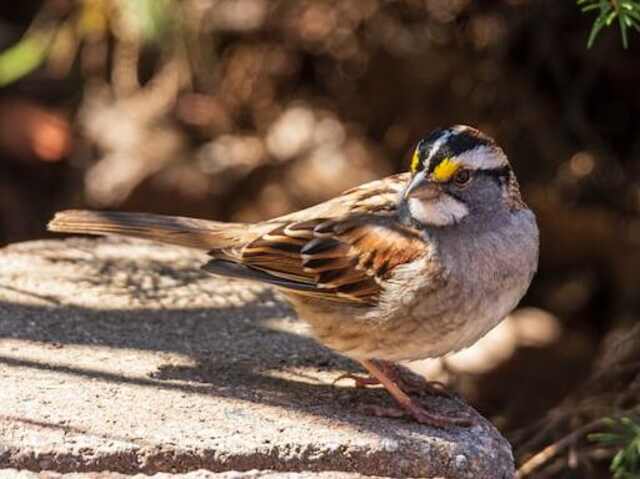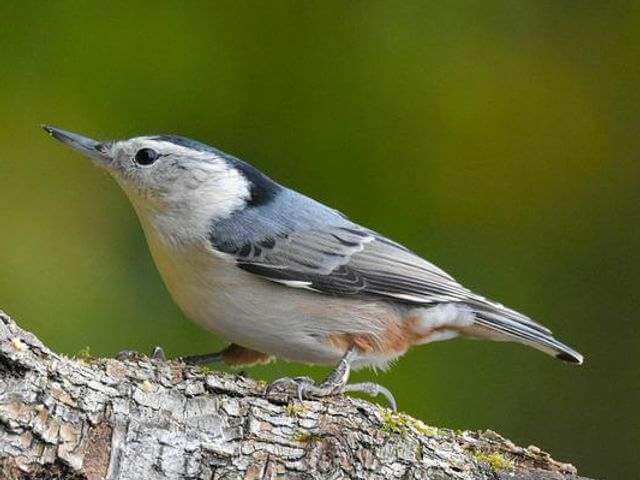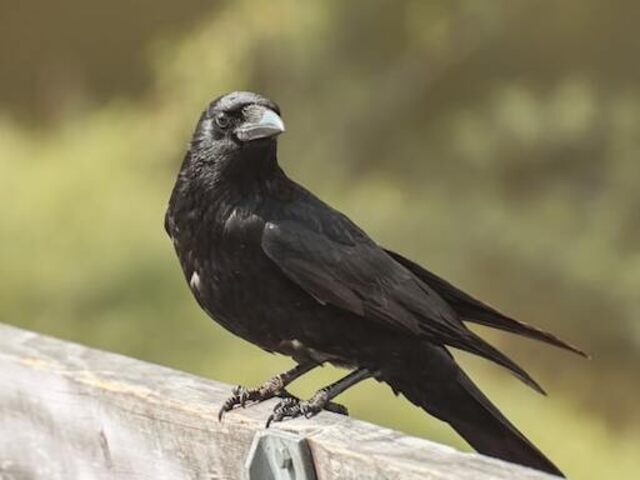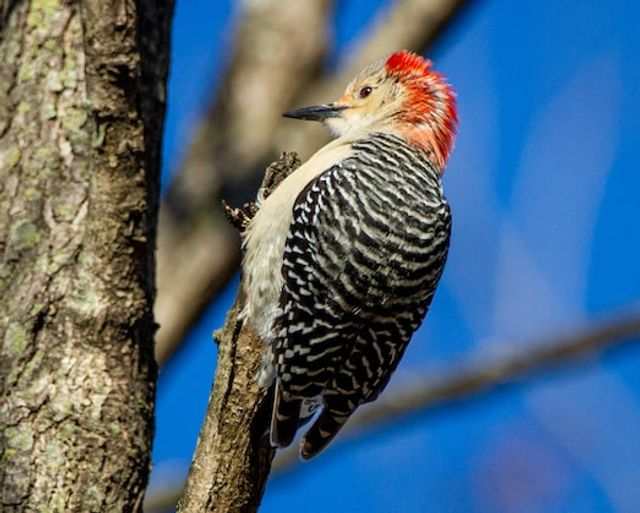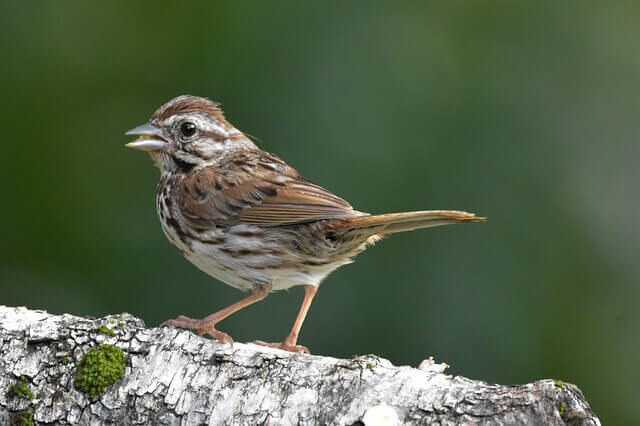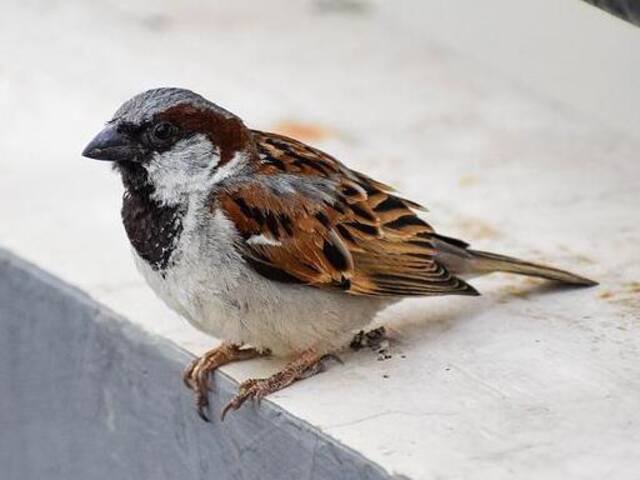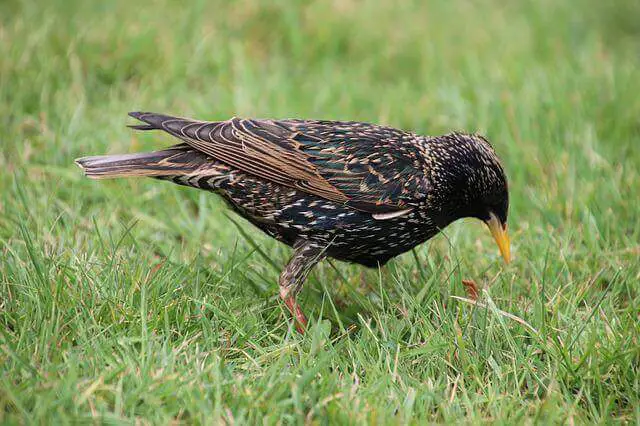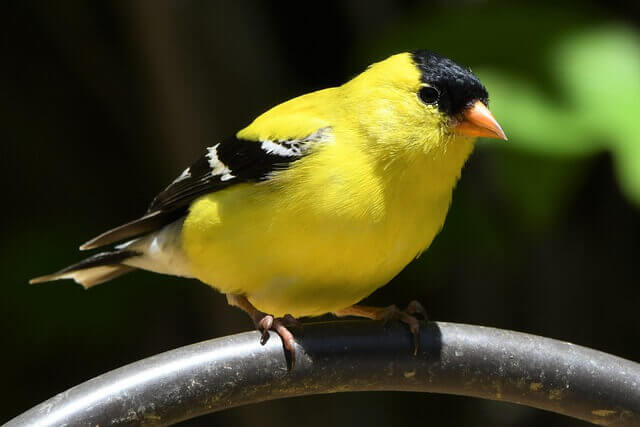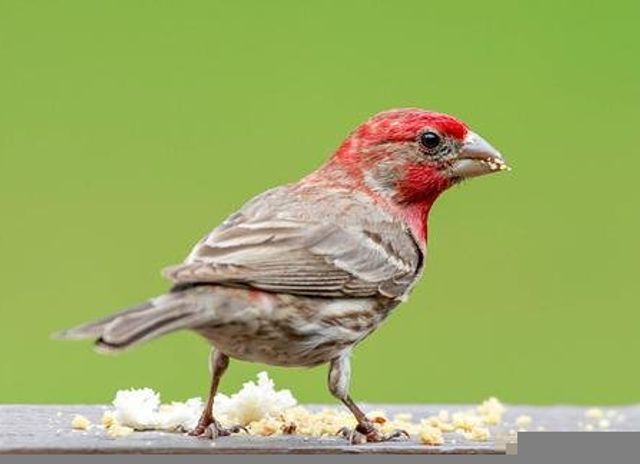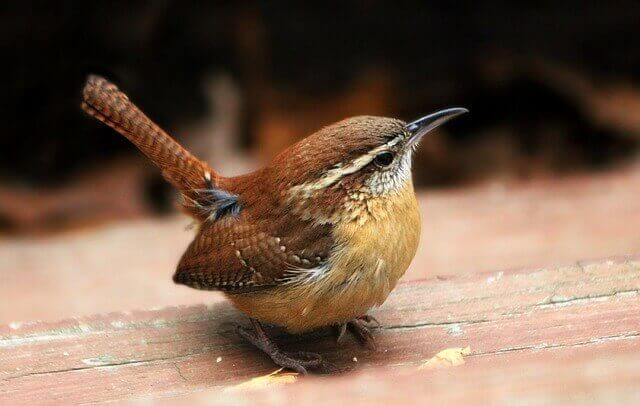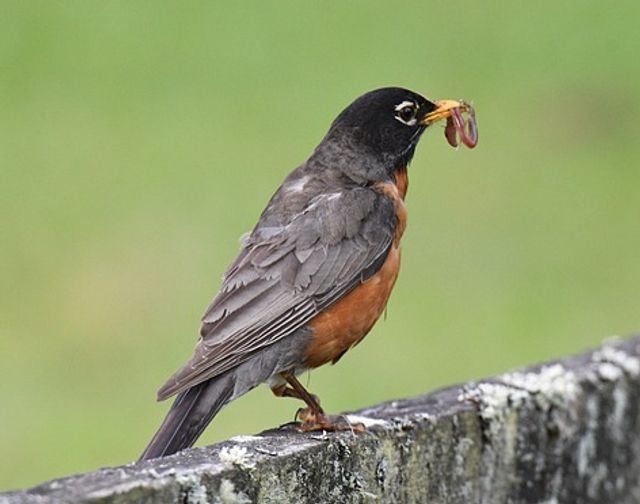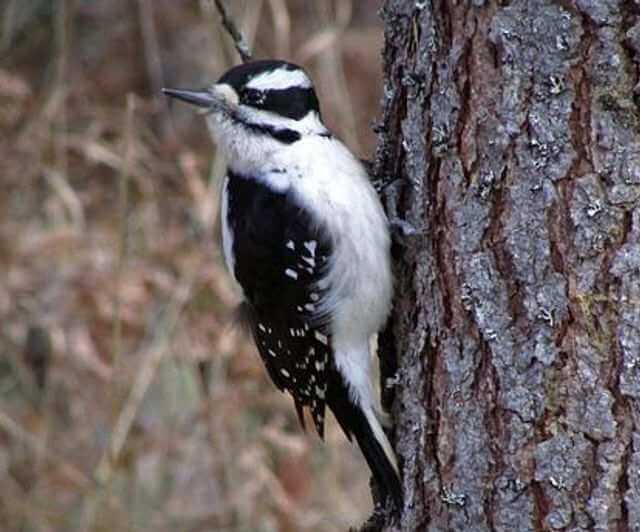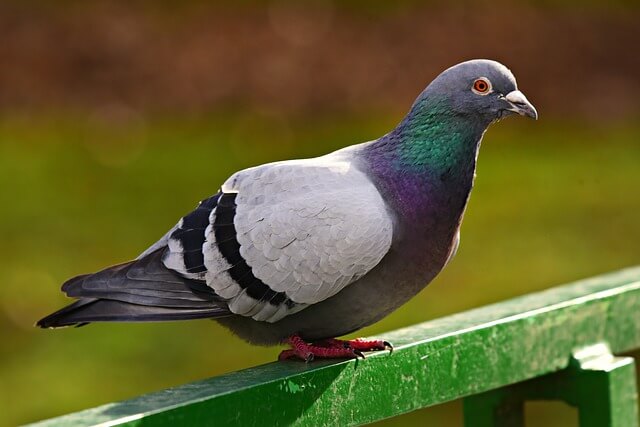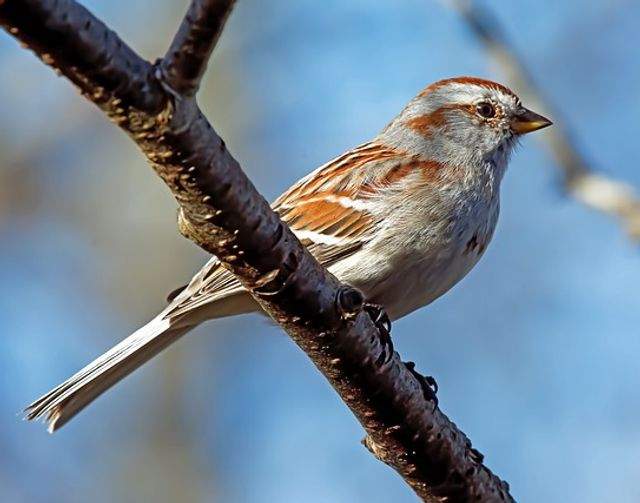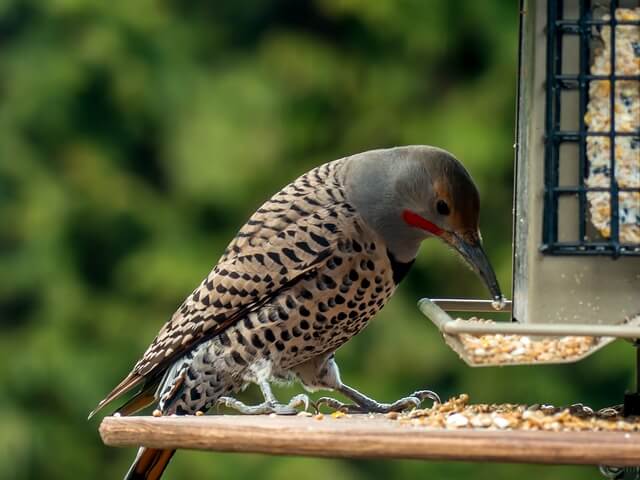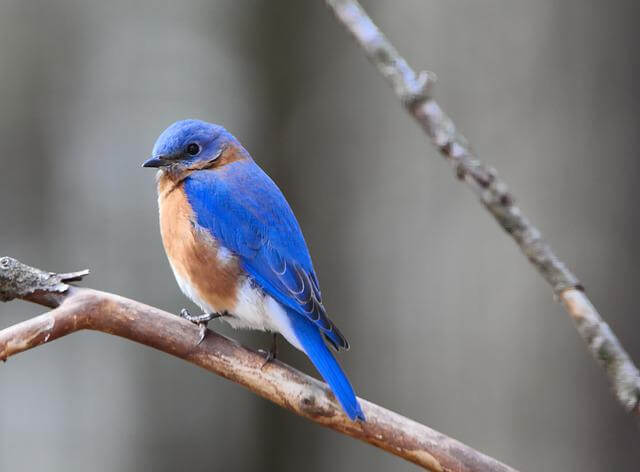Embark on a journey through Connecticut’s winter wonderland with our expert guide to the 24 backyard bird species! From the vibrant Northern Cardinal to the elusive Dark-eyed Junco, Connecticut’s urban and suburban areas become a haven for avian visitors during the winter months.
In this comprehensive guide, we’ll uncover the unique characteristics, habitats, and behaviors of each species, offering valuable insights for bird enthusiasts and nature lovers alike.
Table of Contents
- 1 Backyard Winter Birds in Connecticut
- 1.1 Black-capped Chickadee
- 1.2 Dark-eyed Junco
- 1.3 Northern Cardinal
- 1.4 Blue Jay
- 1.5 Downy Woodpecker
- 1.6 Tufted Titmouse
- 1.7 White-throated Sparrow
- 1.8 White-breasted Nuthatch
- 1.9 Mourning Dove
- 1.10 American Crow
- 1.11 Red-bellied Woodpecker
- 1.12 Song Sparrow
- 1.13 House Sparrow
- 1.14 European Starling
- 1.15 American Goldfinch
- 1.16 House Finch
- 1.17 Carolina Wren
- 1.18 American Robin
- 1.19 Hairy Woodpecker
- 1.20 Rock Pigeon
- 1.21 Northern Mockingbird
- 1.22 American Tree Sparrow
- 1.23 Northern Flicker
- 1.24 Eastern Bluebird
- 2 Author
Backyard Winter Birds in Connecticut
Black-capped Chickadee
- Length: 4.7-6.0″ in (12.0-15.2 cm)
- Weight: 0.3-0.5 oz. (9-14 g)
- Wingspan: 6.3-8.3 in (16-21 cm)
- Scientific Name: Poecile atricapillus
- Frequency of Occurrence: 43.56%(Statistic by: eBird)
- Maps: Range Map – Sightings Map
- Sounds: Calls and Sounds
- Where To Find Them: In Connecticut, the bird can be seen in the towns of Wallingford, Cheshire, and Pomfret. They are usually found in woodland areas, and they like to feed on insects and seeds.
- How to Attract Them: They are attracted to a variety of things, but one of their favorite foods is peanuts. If you have a feeder full of peanuts, you’re more likely to see black-capped chickadees around your yard. Another way to attract these birds is by putting out a dish of black oil sunflower seeds.
General Information: The black-capped chickadee is a small, brown bird that ranges across North America. This bird is common in both urban and rural areas, and it can be found in a variety of habitats including suburban gardens, open forest, and marshes. The black-capped chickadee diet consists mostly of insects, but it also eats seeds and berries.
It has a long life cycle, with chicks growing into adults in just one year. Black-capped chickadees are social birds that live in large colonies. They are very active and spend a lot of time flying around.
Handpicked Related Post: Unique Black-capped Chickadee Facts You Need To Know!
Dark-eyed Junco
- Length: 5.5-6.3 in (14-16 cm)
- Weight: 0.6-1.1 oz. (18-30 g)
- Wingspan: 7.1-9.8 in (18-25 cm)
- Scientific Name: Junco hyemalis
- Frequency of Occurrence: 40.59%
- Maps: Range Map – Sightings Map
- Sounds: Calls and Sounds
- Where To Find Them: The Dark-eyed Junco is a common bird in Connecticut. You can see them in many places, but some of the best spots are at the Kettle Town State Park and the Housatonic River Valley.
- How to Attract Them: If you’re looking to attract Dark-eyed Juncos to your yard, one of the best things you can do is offer them a food source. Hulled sunflower seeds are a great option because they’re high in fats and proteins, which birds love. You can also try is white proso millet, which is an affordable grain that contains all the essential nutrients birds need. Cracked corn also works great.
General Information: The dark-eyed junco is a small, sparrow-sized bird that ranges across much of the United States and Canada. It is a common visitor to suburban and urban areas, where it can be seen feeding on insects, seeds, nuts, and grains. It forms colonies in open areas with plenty of food sources such as fields, parks, and gardens.
These birds are typically nonmigratory; however, they may travel short distances to forage in new areas when existing food sources become scarce. This species is generally a shy bird that avoids human contact unless it feels threatened.
Handpicked Related Post: Fun Facts About Dark-eyed Juncos
Northern Cardinal
- Length: 8.3-9.1 in (21-23 cm)
- Weight: 1.5-1.7 oz. (42-48 g)
- Wingspan: 9.8-12.2 in (25-31 cm)
- Scientific Name: Cardinalis cardinalis
- Frequency of Occurrence: 38.37%
- Maps: Range Map – Sightings Map
- Sounds: Calls and Sounds
- Where To Find Them: When looking for a bird to watch during winter, bird enthusiasts should consider checking out some of the more dramatic locations in Connecticut. One excellent spot is Tyler Milles Preserve, located just north of Hartford. Another great place to see these birds is Great Meadows Marsh, located in the town of Stratford.
- How to Attract Them: Install a platform feeder that has a wide variety of food options, including safflower, black oil sunflower seeds and white milo. Cardinals love these types of feeders because they offer a nutritious and varied diet.
General Information: Northern cardinals are spread throughout the eastern and central United States, Central America, and parts of South America. These birds prefer a wide variety of habitats, from dense forests to more open areas. Cardinals consume a wide range of food items, including seeds, grains, insects, berries, and fruits.
However, they primarily feed on seeds in the early morning and late afternoon. Cardinals are social birds that often forage in groups. They also display cooperative breeding behavior.
Handpicked Related Post:
- 10 Best Bird Feeders for Cardinals (Rated for 2022)
- Best Birdhouse for Cardinals 2022 (Tested And Rated)
- Where Are Cardinals Found? Best Spots to Look!
Blue Jay
- Length: 9.8-11.8 in (25-30 cm)
- Weight: 2.5-3.5 oz. (70-100 g)
- Wingspan: 13.4-16.9 in (34-43 cm)
- Scientific Name: Cyanocitta cristata
- Frequency of Occurrence: 37.92%
- Maps: Range Map – Sightings Map
- Sounds: Calls and Sounds
- Where To Find Them: In Connecticut, Blue Jays can be seen in wintertime at the following locations: West Haven, Norwalk, Danbury, New Canaan, Waterbury.
- How to Attract Them: They are attracted to bird feeders with peanuts and sunflower seeds, but you can also feed them cracked corn.
General Information: The Blue Jay is a common bird found in North America. It is found in a variety of habitats, but prefers areas with plenty of trees and shrubs. The Blue Jay diet consists mostly of seeds, nuts, fruits, and small arthropods. They are also known to consume small vertebrates, such as rodents and birds.
The Blue Jay is a frugal bird, which means that it spends a lot of its time foraging for food. It often hunts by flying around and looking for prey opportunities. When it finds something to eat, it will often snatch it up with its beak before flying away.
Handpicked Related Post:
- 15 Best Bird Feeders For Blue Jays (Tried & Tested 2022)
- What Attracts Blue Jays to your Yard?(Expert Tips)
- What Does A Blue Jay Eat? (10 Favorite Foods Revealed!)
Downy Woodpecker
- Length: 5.5-6.7 in (14-17 cm)
- Weight: 0.7-1.0 oz. (21-28 g)
- Wingspan: 9.8-11.8 in (25-30 cm)
- Scientific Name: Picoides pubescens
- Frequency of Occurrence: 36.73%
- Maps: Range Map – Sightings Map
- Sounds: Calls and Sounds
- Where To Find Them: Some popular places to see the Downy Woodpecker in Connecticut during winter include Rocky Hill State Park, and Colt Park. All of these areas offer great opportunities for spotting this bird in its natural habitat.
- How to Attract Them: Downy Woodpeckers are one of the most commonly seen birds in wintertime. They are attracted to bird feeders that have black oil sunflower seeds and millet as the primary ingredients. You can also try adding peanuts to your feeder as a supplementary food source.
General Information: The Downy Woodpecker is a small woodpecker found in the eastern and central United States. They range from southern Maine to Texas, and west to Oklahoma and Kansas. They are most common in the Appalachian Mountains, but they are also present in other areas of the east.
The Downy Woodpecker is a tree-dwelling bird and is mainly found in forests, but it will also inhabit plantations and orchards. This bird feeds on insects, fruit, seeds and nuts. It breeds in cavities in trees, but will also use holes in cliffs, poles or abandoned buildings.
Handpicked Related Post: How to Attract Downy Woodpeckers to Your Yard? (Easy!)
Tufted Titmouse
- Length: 5.5-6.3 in (14-16 cm)
- Weight: 0.6-0.9 oz. (18-26 g)
- Wingspan: 7.9-10.2 in (20-26 cm)
- Scientific Name: Baeolophus bicolor
- Frequency of Occurrence: 36.65%
- Maps: Range Map – Sightings Map
- Sounds: Calls and Sounds
- Where To Find Them: The Tufted Titmouse can be seen in Connecticut in wintertime, specifically in the areas around Middletown and Branford. Observers have noted that this species is typically more active during the morning and late afternoon hours, so it’s worth checking out some of these spots during those times if you’re interested in spotting this bird!
- How to Attract Them: If you’re looking to attract a Tufted Titmouse to your yard in winter, one approach is to feed them black oil sunflower seeds. Safflower also makes a good food for these birds, and can be purchased at most pet stores. Mealworms served on a platform feeder are another great option for winter bird feeding, as they are high in protein and fat.
General Information: The Tufted Titmouse is a small bird found in the eastern United States. The Tufted Titmouse prefers habitats with dense vegetation, such as mixed hardwood forests and laurel thickets. They are omnivorous, feeding on insects, seeds, nuts, berries and fruit. They are typically shy and difficult to see, but are active during the morning and evening hours.
They fly short distances when moving around their habitat, but typically stay within close proximity to trees. The Tufted Titmouse mates for life and will build a nest in cavities high up in a tree.
Handpicked Related Post: How to Attract Tufted Titmouse to my Yard? (Explained)
White-throated Sparrow
- Length: 6.3-7.1 in (16-18 cm)
- Weight: 0.8-1.1 oz. (22-32 g)
- Wingspan: 7.9-9.1 in (20-23 cm)
- Scientific Name: Zonotrichia albicollis
- Frequency of Occurrence: 33.06%
- Maps: Range Map – Sightings Map
- Sounds: Calls and Sounds
- Where To Find Them: In wintertime, the White-throated Sparrow can be seen in a few different locations in Connecticut. One place is at Rocky Hill State Park, which is known for its large population of this bird. Another place where you can see the White-throated Sparrow in wintertime is at West Rock Ridge State Park in New Haven. This park has a lot of open fields and wooded areas, which makes it a great spot for the Sparrow to live and hunt.
- How to Attract Them: In order to attract White-throated Sparrow to your yard in winter, you can try using a tube feeder with sunflower seeds. The birds will love the taste of the seeds and will be drawn to the feeder every day. You can also offer millet as an alternative food source.
General Information: The white-throated sparrow is a common bird in the eastern United States. The sparrow ranges from southern New Hampshire, throughout most of Massachusetts, Connecticut, Rhode Island, and Maine south to Florida and Texas. In the east, the sparrow also inhabits parts of Pennsylvania, Ohio, and West Virginia.
This sparrow is found in both open and closed habitats, including fields, forests, towns, and suburbs. The White-throated Sparrow is generally a shy bird that avoids humans. It feeds primarily on seeds, but also eats small amounts of fruits and insects. The White-throated Sparrow is an active bird that forages on the ground or in trees.
White-breasted Nuthatch
- Length: 5.1-5.5 in (13-14 cm)
- Weight: 0.6-1.1 oz. (18-30 g)
- Wingspan: 7.9-10.6 in (20-27 cm)
- Scientific Name: Sitta carolinensis
- Frequency of Occurrence: 32.17%
- Maps: Range Map – Sightings Map
- Sounds: Calls and Sounds
- Where To Find Them: If you’re a bird-lover in Connecticut during the winter, be sure to check out some of the state’s most notable spots where you can see the White-breasted Nuthatch. Some of these locations include Rocky Hill Trail, Quinnipiac Meadows, and Hop River State Park Trail. All three of these parks have habitats that are conducive to this species’ needs, such as large trees with plenty of high branches for nests.
- How to Attract Them: Choose a platform feeder that’s large enough for the nuthatches to feed from comfortably. The birds love to perch atop a tall structure, so make sure the feeder you choose offers plenty of height. Fill your feeder with sunflower seeds, or offer nuts or mealworms as well. These are favorite foods of nuthatches, so providing them in bulk will encourage them to visit your yard more often.
General Information: The white-breasted nuthatch ranges throughout the eastern United States and is the most common nuthatch in North America. This small bird is typically seen in open woodlands, where it forages for seeds, insects, and fruits. The white-breasted nuthatch is also known to eat nuts, but this behavior is not as common as other food items. The white-breasted nuthatch has a wide variety of habitats including deciduous and mixed forests, wetlands, orchards, and urban areas.
It tends to be more common near sources of water such as streams or ponds. The white-breasted nuthatch typically nests in cavities such as old woodpecker holes or even in the eaves of houses. This bird has a strong social dynamic and often forms large colonies.
Handpicked Related Post: How to Attract Nuthatches to your Backyard? Expert Tips!
Mourning Dove
- Length: 9.1-13.4 in (23-34 cm)
- Weight: 3.4-6.0 oz. (96-170 g)
- Wingspan: 17.7 in (45 cm)
- Scientific Name: Zenaida macroura
- Frequency of Occurrence: 31.97%
- Maps: Range Map – Sightings Map
- Sounds: Calls and Sounds
- Where To Find Them: When the weather starts to cool down in Connecticut, one of the first places you can see the Mourning Dove is at Rocky Hill. The reservoir is a great spot to see these beautiful birds because it is surrounded by dense forest. Another great place to see the Mourning Dove in wintertime is at Bluff Point State Park.
- How to Attract Them: Mourning doves enjoy eating sunflower seeds, safflower seeds, and cracked corn from platform feeders during the winter months. These food sources will help attract these beautiful birds to your yard. You can also offer them nyjer berries as a supplemental food source.
General Information: Mourning doves are widespread throughout the United States, and can be found in most states. The mourning dove is a migratory bird, so it will typically move to different parts of the country each year. The primary habitat for mourning doves is open areas with lots of trees, but they can also be found in urban environments.
They prefer to live in wet areas, such as marshes and swamps. The diet of the mourning dove includes seeds, fruit, waste grain, and insects. They will typically eat small amounts of food every day, so they don’t need to eat very often. Mourning doves usually feed on the ground or in low-hanging branches.
Handpicked Related Post: Facts About Mourning Doves – 10 Things You Need To Know!
American Crow
- Length: 15.8-20.9 in (40-53 cm)
- Weight: 11.2-21.9 oz. (316-620 g)
- Wingspan: 33.5-39.4 in (85-100 cm)
- Scientific Name: Corvus brachyrhynchos
- Frequency of Occurrence: 31.60%
- Maps: Range Map – Sightings Map
- Sounds: Calls and Sounds
- Where To Find Them: The American Crow can be seen throughout the state during winter, but some of the best places to see them are in Fairfield County, and Eagleville Pond, These are two great places to check out this majestic bird in action.
- How to Attract Them: One way to attract crows is by providing them with food sources such as sunflower seeds or peanuts. Do not feed the birds human food, as this will only encourage them to come into contact with humans and create nuisance problems.
General Information: The American crow is a common bird in North America. The American crow can be found in all 50 states and in many Canadian provinces. The American crow ranges from the Arctic tundra to the tropics and from high mountains to lowlands. The American crow prefers open habitats such as grasslands, farmland, and urban areas. The diet of the American crow includes grains, seeds, nuts, fruits, and berries. The grains include wheat, corn, oats, rice, barley, and millet.
Seeds include sunflower seeds, pumpkin seeds, flaxseed, chia seeds, and hemp seeds. Nuts include almonds and walnuts. Fruits include grapes, apples, oranges,, plums,, cherries,, cranberries,, raspberries,, blackberries,. Berries include strawberries,. Small animals eaten by the American Crow include rodents such as mice and rats.
Handpicked Related Post: How To Attract Crows To Your Backyard: Expert Tips!
Red-bellied Woodpecker
- Length: 9.4 in (24 cm)
- Weight: 2.0-3.2 oz. (56-91 g)
- Wingspan: 13.0-16.5 in (33-42 cm)
- Scientific Name: Melanerpes carolinus
- Frequency of Occurrence: 27.61%
- Maps: Range Map – Sightings Map
- Sounds: Calls and Sounds
- Where To Find Them: The Red-bellied Woodpecker can be seen in wintertime in Connecticut. Some of the places where you might see this bird are in Killingworth, West Hartford, and Windsor.
- How to Attract Them: Sunflower seeds are a great way to attract the Red-bellied Woodpecker to your yard in winter. Suet is also an effective food source for these birds. Peanuts are a good supplemental food source, but should not be the only thing available to the woodpeckers.
General Information: The Red-bellied Woodpecker is a common bird in the United States. They are found in most states, but are particularly prevalent in the eastern and southern parts of the country. They range from north central Texas to northern Florida, west through Arkansas and Oklahoma to Kansas and Missouri, south through Louisiana to northern Georgia, and east through Virginia and North Carolina to Maryland and Delaware.
These birds may live in a variety of habitats, from deciduous and coniferous forests to suburbs. This woodpecker is known for its strong beak and piercing call. Like other woodpeckers, it feeds on insects and larvae found in the trees. The red-bellied woodpecker has a diet that includes mainly insects, but they will also eat small birds or mammals if they find them.
Handpicked Related Post: How to Attract Red-bellied Woodpeckers to your Yard?
Song Sparrow
- Length:4.7-6.7 in (12-17 cm)
- Weight: 0.4-1.9 oz. (12-53 g)
- Wingspan: 7.1-9.4 in (18-24 cm)
- Scientific Name: Melospiza melodia
- Frequency of Occurrence: 27.54%
- Maps: Range Map – Sightings Map
- Sounds: Calls and Sounds
- Where To Find Them: If you’re looking for a spot to see the Song Sparrow in winter, be sure to check out Old Saybrook and Branford, both of which are known for their high populations of this bird.
- How to Attract Them: To attract Song Sparrow to your yard in winter, you can use a feeder with millet seeds. This type of feeder will give the birds a diverse diet and help them keep their energy up during the cold months.
General Information: The Song Sparrow is a small bird that resides in North America. The Song Sparrow ranges from the Central United States to the northern reaches of Mexico. This bird is found in deciduous and mixed woodlands, as well as scrub areas. The population of this species has been increasing in recent years, likely due to the restoration of habitats throughout its range.
Song Sparrows are omnivorous birds that feed on seeds, grasses, weeds, and insects. They will also take small amounts of birdseed when available. Song Sparrows generally forage on the ground or low in trees, but are able to fly short distances if necessary.
Handpicked Related Post: How to Attract Sparrows to your Backyard? (Like A Pro)
House Sparrow
- Length: 5.9-6.7 in (15-17 cm)
- Weight: 0.9-1.1 oz. (27-30 g)
- Wingspan: 7.5-9.8 in (19-25 cm)
- Scientific Name: Passer domesticus
- Frequency of Occurrence: 26.14%
- Maps: Range Map – Sightings Map
- Sounds: Calls and Sounds
- Where To Find Them: House Sparrows can be seen in Connecticut in winter. The following are some places where you can see the House Sparrow in winter are, Hartford, New Haven, and West Simsbury are all good places to see the House Sparrow because there are many parks and gardens nearby.
- How to Attract Them: If you’re looking to attract house sparrows to your yard in winter, one easy way is to offer them a dish of millet or milo seeds. These small, seed-rich plants are a favorite food of the sparrows, and they will come to your yard in search of them. You can also try scattering sunflower seeds around your yard as a supplemental food source. Both millet and sunflower seeds are high in energy and will keep the sparrows busy during the cold months.
General Information: House Sparrows have a very widespread range, found throughout North America and parts of South America. They are commonly found in urban areas and suburban areas, as well as rural areas. They prefer to live in trees, but will also inhabit buildings and other structures. House Sparrows are omnivorous feeders and will eat a variety of things, including grains, seeds, insects, discarded food.
They are able to extract food from hard surfaces such as windowsills and door frames. House Sparrows socialize extensively with one another and often coexist peacefully with other species of birds. However, they will fiercely defend their nests against other birds or predators.
European Starling
- Length: 7.9-9.1 in (20-23 cm)
- Weight: 2.1-3.4 oz. (60-96 g)
- Wingspan: 12.2-15.8 in (31-40 cm)
- Scientific Name: Sturnus vulgaris
- Frequency of Occurrence: 24.17%
- Maps: Range Map – Sightings Map
- Sounds: Calls and Sounds
- Where To Find Them: If you’re looking for a spot in Connecticut where you can see the European Starling in winter, look no further than the wetlands of Kent. Another place where you may be able to see this uncommon bird in Connecticut are around the Quinnipiac River.
- How to Attract Them: If you’re looking to attract European Starling to your yard in winter, a platform feeder with mealworms or sunflower seeds is a great option. These birds love to eat insects, so providing them with a variety of food options will keep them happy and healthy.
General Information: The European starling is a common bird in many parts of the world, but its distribution is patchy in North America. In Europe, these birds are found in a wide range of habitats from open country to cities. European starlings are omnivorous and consume a variety of items including insects, larvae, small vertebrates and fruit. They typically feed on the ground or low in trees, but they will also take food from the air.
Individuals generally forage singly or in pairs, and seldom join groups of greater than six birds. They search for food by walking or flying around until they find something that looks edible. European starlings usually eat small quantities at a time and often wait until other animals have moved away before attacking their prey.
Handpicked Related Post: How To Attract European Starlings To Your Yard Fast?
American Goldfinch
- Length: 4.3-5.1 in (11-13 cm)
- Weight: 0.4-0.7 oz. (11-20 g)
- Wingspan: 7.5-8.7 in (19-22 cm)
- Scientific Name: Spinus tristis
- Frequency of Occurrence: 23.83%
- Maps: Range Map – Sightings Map
- Sounds: Calls and Sounds
- Where To Find Them: Some places where you can see this bird during the winter are at the Quinnipiac Meadows, on Long Island Sound, and in West Hartford.
- How to Attract Them: If you are looking to attract American Goldfinch to your yard in winter, one option is to feed them a tube feeder with nyjer or sunflower seeds. These birds are attracted to brightly-colored objects and will often feed from a bird feeder that contains these types of seeds. Make sure the seed mixture you use is fresh, and change it regularly in order to keep the birds interested.
General Information: The American Goldfinch is a small songbird that resides in North America. The Goldfinch is a passerine bird and is the most common species of finch found in the United States. The American Goldfinch ranges across much of North America, from southern Canada to Panama, and west to central Mexico. This bird can be found in a variety of habitats including urban areas, suburban areas, and rural areas.
The diet of the American Goldfinch varies depending on its location. In the north-central United States, the diet consists primarily of seeds from thistles and sunflowers. In the south-central United States, the diet includes seeds from asters as well. In Mexico, the diet includes seeds from both thistles and sunflowers.
Handpicked Related Post: Interesting American Goldfinch Facts You Need to Know!
House Finch
- Length: 5.1-5.5 in (13-14 cm)
- Weight: 0.6-0.9 oz. (16-27 g)
- Wingspan: 7.9-9.8 in (20-25 cm)
- Scientific Name: Haemorhous mexicanus
- Frequency of Occurrence: 22.57%
- Maps: Range Map – Sightings Map
- Sounds: Calls and Sounds
- Where To Find Them: House finches are commonly seen in winter in Connecticut. These small birds can be found near bodies of water, like ponds and lakes. Some spots in Connecticut where you can see the house finch in winter are Prospect Park, Naugatuck State Forest, and New Milford Reservoir Loop.
- How to Attract Them: Attracting house Finch during the winter can be a challenge as they are naturally attracted to warmer environments. One way to attract these birds is by providing them with a tube feeder with black oil sunflower seeds. This will help keep them occupied and happy, ensuring that they stay close to your yard all winter long!
General Information: The house finch is a small bird that ranges throughout North America. This bird has a brightly colored body and can be found in gardens and other open areas. The house finch primarily eats seeds, grains, fruits, and berries. They also eat insects. House finches are monogamous animals and form pairs during the breeding season. They build nests out of dried grasses, feathers, and other materials.
Nests are often placed in high up locations such as trees or poles. House finches usually have two eggs which they incubate for around 14 days. Young birds fledge after around 16 days and will remain with their parents for another eight weeks or so before they start to on their own.
Handpicked Related Post:
- How to Attract House Finch to your Yard? (Easy & Fast)
- 9 Best Birdhouse for Finches? (Rated & Tested for 2022)
Carolina Wren
- Length: 4.7-5.5 in (12-14 cm)
- Weight: 0.6-0.8 oz (18-22 g)
- Wingspan: 11.4 in (29 cm)
- Scientific Name: Thryothorus ludovicianus
- Frequency of Occurrence: 19.63%
- Maps: Range Map – Sightings Map
- Sounds: Calls and Sounds
- Where To Find Them: The carolina wren is a small songbird that can be seen in Connecticut. This bird is found in the eastern half of the state, including the cities of Hartford and Bridgeport. The Carolina wren is a common resident of deciduous and mixed woods. It also frequents suburban areas and open fields.
- How to Attract Them: They are attracted to birdfeeders with a variety of food including mealworms, suet, and black oil sunflower seeds.
General Information: The Carolina wren is a small bird that inhabits Southern Ontario, in Canada, and the eastern and central United States. The Carolina wren ranges from New England to the Gulf of Mexico, and south to Georgia and Florida. This bird is mainly found in deciduous and mixed forests, but can also be found in urban areas.
The Carolina wren is a common visitor to gardens and orchards, where it feeds on insects, small vertebrates, seeds, and vegetable matter. This bird is predominantly a ground feeder, but will also take shelter among tall plants during inclement weather. The Carolina wren is a songbird, and has several different types of songs that it sings during the breeding season.
Handpicked Related Post: How to Attract Wrens to your Backyard? (Expert’s Guide)
American Robin
- Length: 7.9-11.0 in (20-28 cm)
- Weight: 2.7-3.0 oz (77-85 g)
- Wingspan: 12.2-15.8 in (31-40 cm)
- Scientific Name: Turdus migratorius
- Frequency of Occurrence: 15.86%
- Maps: Range Map – Sightings Map
- Sounds: Calls and Sounds
- Where To Find Them: If you’re a bird lover in Connecticut, you’ll be happy to know that you can see the American Robin in winter. Here are a couple of spots where you’re likely to see the American Robin: Hartford: The capital city has long been known as a hot spot for bird watching, and American Robins are no exception. The densely populated area provides plenty of perches for these birds, and they can often be seen perched on light posts or other high-traffic areas. Norwalk: Just northwest of Hartford is Norwalk, which also has an abundance of trees and other vegetation suitable for nesting robins.
- How to Attract Them: If you’re looking for a way to add some excitement to your yard during the winter, you should consider installing a platform feeder with mealworms. American robins are attracted to these types of feeders and will come frequenting your yard in search of food.
General Information: The American Robin is a common bird throughout much of North America. This species ranges from southern Canada to the Gulf of Mexico and west to the Rocky Mountains. American Robins are cavity nesters and use various types of trees and shrubs for nesting. These birds forage for insects, worms, berries, and other small prey in open areas and woodland habitats.
American Robins winter in many different places across their range, but they are most commonly found in wooded areas with dense understory vegetation. In winter, American Robins feed primarily on invertebrates, but will also eat some berries if available. They often feed in groups or families and are very social birds.
Handpicked Related Post:
- How To Attract Robins To Your Yard – 7 Best Tips!
- 5 Best Bird Feeders For Robins (Tested & Rated For 2022)
- Interesting American Robin Fun Facts (Explained)
Hairy Woodpecker
- Length: 7.1-10.2 in (18-26 cm)
- Weight: 1.4-3.4 oz (40-95 g)
- Wingspan: 13.0-16.1 in (33-41 cm)
- Scientific Name: Leuconotopicus villosus
- Frequency of Occurrence: 13.04%
- Maps: Range Map – Sightings Map
- Sounds: Calls and Sounds
- Where To Find Them: The Hairy Woodpecker can be seen in winter in Connecticut, but there are a couple key locations where you’re more likely to spot this ornate bird. One location is the Connecticut State Forest in East Hartford where there are several mature trees with plenty of dead wood for the Hairy Woodpecker to make its home. Another spot is in Rocky Hill Trail where a large number of White Pines grow, providing plenty of deadwood for the Hairy Woodpecker to nest and roost.
- How to Attract Them: When it comes to attracting the hairy woodpecker to your yard in winter, there are a few things you can do. One way is to feed them suet or peanut or black oil sunflower seeds. These are all good sources of energy for the birds, and they will appreciate the food.
General Information: The hairy woodpecker is a common bird throughout its range, found in North America from the Arctic tundra to the tropics. This species inhabits a wide variety of habitats, including deciduous and coniferous forests, open fields, suburban areas and even urban gardens.
The hairy woodpecker is a diurnal bird, and it forages mainly for insects and small invertebrates. Some of its favorite foods include beetles, grasshoppers, caterpillars, spiders and other small creatures. In winter, this woodpecker often eats nuts, seeds and berries.
Rock Pigeon
- Length:11.8-14.3 in(30-36 cm)
- Weight: 9.3-13.4 oz (265-380 g)
- Wingspan: 19.7-26.5 in (50-67 cm)
- Scientific Name: Columba livia
- Frequency of Occurrence: 9.76%
- Maps: Range Map – Sightings Map
- Sounds: Calls and Sounds
- Where To Find Them: If you’re looking to see the Rock Pigeon in Connecticut during winter, some of the best spots are along the Housatonic Valley and in Litchfield County.
- How to Attract Them: To attract these birds, start by scattering sunflower or safflower seeds around your property. These birds love eating these types of seeds and will come looking for them. If you have a lot of open space, you can also try scattering peanuts without the shell around your yard as well. This type of seed is especially popular with rock pigeons because they like the crunchy texture.
General Information: Rock pigeons reside in a wide variety of habitats and can be found across North America. They typically forage for seeds, fruits, and invertebrates in the winter, but their diet can vary based on location. In the west, they feed largely on grasses while in the East they consume more fruit.
Both populations tend to scavenge food from human environments, though this varies by region. Rock pigeons are social birds that live in large flocks. Their distinctive cooing is often heard during migrations and during breeding season.
Northern Mockingbird
- Length:8.3-10.2 in (21-26 cm)
- Weight: 1.6-2.0 oz (45-58 g)
- Wingspan: 12.2-13.8 in (31-35 cm)
- Scientific Name: Mimus polyglottos
- Frequency of Occurrence: 9.67%
- Maps: Range Map – Sightings Map
- Sounds: Calls and Sounds
- Where To Find Them: In Connecticut, you can see the Northern Mockingbird in winter at several locations. One spot is in the Albany area, where there are many deciduous trees. Another location is in Wolcott, where there are many areas of woods and wetlands. In Hartford, you can see the Northern Mockingbird at Prospect Park and at Sims Park.
- How to Attract Them: To help attract Northern Mockingbirds to your yard in winter, you can offer them a platform feeder with a mealworm diet supplemented with the occasional sliced fruit.
General Information: The Northern Mockingbird ranges throughout the eastern U.S. and Canada, with the exception of some areas in the northeast corner of Manitoba and Northwest Territories. In winter, this bird can be found in a wide variety of habitats including deciduous and coniferous forests, urban areas and suburbs.
Northern Mockingbirds are insectivores, but they also consume small animals such as spiders, beetles, grasshoppers, and earthworms. They are particularly fond of seeds, berries and fruit, which are abundant in their habitat. Northern Mockingbirds often forage in groups, and are territorial.
Handpicked Related Post: How to Attract Mockingbirds to your Yard? (Expert Tips)
American Tree Sparrow
- Length: 5.5 in (14 cm)
- Weight: 0.5-1.0 oz (13-28 g)
- Wingspan: 9.4 in (24 cm)
- Scientific Name: Spizelloides arborea
- Frequency of Occurrence: 9.35%
- Maps: Range Map – Sightings Map
- Sounds: Calls and Sounds
- Where To Find Them: If you’re looking for a place to spot the American Tree Sparrow in winter, look no further than Connecticut. This seabird can be found in many parts of the state, including the cities of Bridgeport, Hartford and New Haven.
- How to Attract Them: In order to attract these birds to your yard in winter, you will need to provide them with food sources such as cracked corn and sunflower seeds. Millet is also a good option for these birds, as it is high in fiber and nutrients which can help keep them healthy during the colder months.
General Information: The American Tree Sparrow is a common bird in North America. They range from the south-central United States, through most of Canada, to the northern border of Mexico. Due to its widespread distribution throughout North America, the American Tree Sparrow is found in many different habitats including forests, parks, fields, suburbs and even urban areas.
Tree sparrows are omnivorous, eating seeds, insects, berries, and grasses. In winter, they eat mostly grasses and weeds. They often forage on the ground, but can also perch for long periods of time if the opportunity arises.
Handpicked Related Post: 10 Fascinating American Tree Sparrow Facts
Northern Flicker
- Length: 11.0-12.0 in (28-31 cm)
- Weight: 3.9-5.6 oz. (110-160 g)
- Wingspan: 16.5-20.0 in (42-51 cm)
- Scientific Name: Colaptes auratus
- Frequency of Occurrence: 8.81%
- Maps: Range Map – Sightings Map
- Sounds: Calls and Sounds
- Where To Find Them: The Northern Flicker can be seen in Connecticut in winter. Some Locations Include: Windsor Locks, Killingworth, East Haddam, and Enfield.
- How To Attract: If you’re looking to attract Northern Flickers to your yard in winter, there are a few things you can do. One is to offer them a suet feeder with peanut butter suet or peanuts as a food source. Safflower and black-oil sunflower seeds also makes a good food for these birds, so include some in your offerings.
General Information: The Northern Flicker (Colaptes auratus) is a common bird found in North America. The Northern Flicker ranges from the eastern border of Manitoba to the Gulf of Mexico and south to Florida. The habitat of the Northern Flicker includes coniferous, deciduous, mixed forests, and swamps. The diet of the Northern Flicker consists largely of insects such as flies, butterflies, moths, beetles.
The Northern Flicker peaks in activity during winter, when it consumes fruits and seeds. Winter is also the time when the male Northern Flickers displays its colors by flashing its wings and tail feathers.
Handpicked Related Post: How to Attract Northern Flickers to your Backyard (Easy)
Eastern Bluebird
- Length: 6.3-8.3 in (16-21 cm)
- Weight: 1.0-1.1 oz. (28-32 g)
- Wingspan: 9.7-12.5″in. (25-32 cm)
- Scientific Name: Sialia sialis
- Frequency of Occurrence: 8.05%
- Maps: Range Map – Sightings Map
- Sounds: Calls and Sounds
- Where To Find Them: Eastern Bluebirds have been spotted in much of Connecticut during the winter months, but a few spots are particularly good for seeing these birds. The best place to find Eastern Bluebirds during the winter is at the Cedar Swamp Trail, which is located in Hampton County.
- How to Attract Them: Install a platform feeder with mealworms on your property. This will provide the birds with a continuous supply of fresh food, and they will soon become regulars at your feeder. Make sure the feeder is full of fresh food every day, and don’t leave any uneaten meals behind. This will keep the worms healthy and active, which will attract more bluebirds to your yard.
General Information: The Eastern Bluebird is a small, shy bird that spends the majority of its time in the trees canopy. This bird is found in North America throughout much of Canada and the United States. The Eastern Bluebird ranges from Florida to Maine, with a significant population in New Jersey.
They are often seen in open areas near woods, or in suburban gardens. This bird feeds mainly on insects and other small invertebrates, but will also eat fruits and berries when available. In the winter, they will supplement their diet with wild fruit and berries.
Handpicked Related Post:
- How to Attract Eastern Bluebirds to your Yard (Explained)
- 60 Fun Facts About Eastern Bluebirds (You Didn’t Know!)
- 9 Best Birdhouses for Bluebirds (Top Picks for 2022)
Related Post: 52 Most Common Backyard Birds in Connecticut (2022)

